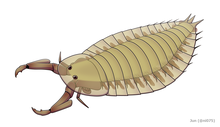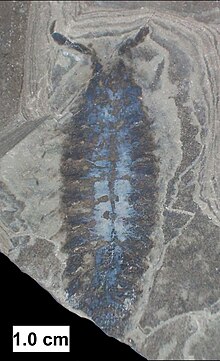Parioscorpio is an extinct genus of arthropod containing the species P. venator known from the Silurian-aged Waukesha Biota of the Brandon Bridge Formation near Waukesha, Wisconsin. This animal has gone through a confusing taxonomic history, being called an arachnid, crustacean, and an artiopodan arthropod at various points.[1] [2] [3] This animal is one of the more famous fossil finds from Wisconsin, due to the media coverage it received based on its original description in 2020 as a basal scorpion.[4][5][6]
| Parioscorpio | |
|---|---|

| |
| Reconstruction as a non-scorpion, enigmatic arthropod | |

| |
| Fossil specimen of Parioscorpio venator | |
| Scientific classification | |
| Domain: | Eukaryota |
| Kingdom: | Animalia |
| Phylum: | Arthropoda |
| Genus: | †Parioscorpio Wendruff et al, 2020 |
| Type species | |
| †Parioscorpio venator Wendruff et al, 2020
| |
Taxonomy
editThe fossils were originally discovered in 1985, tentatively identified as a branchiopod or remipede crustacean[1][7] but were neglected for decades. [8] In 2016, some of the fossils now assigned to Parioscorpio were given the name Latromirus and were assigned to an extinct group of early Paleozoic arthropods known as cheloniellids in a Ph.D dissertation,[9] but the name was never published in a peer-reviewed journal and is therefore not valid in accordance with the International Code of Zoological Nomenclature. The fossils known as “Latromirus” were also mistakenly named “Xus yus” in a preprint of a separate paper. [10] Upon initial publication in 2020, Parioscorpio was considered the world's oldest and most primitive known scorpion, older than Dolichophonus from Scotland by several million years.[3] In 2021, the fossils were reanalysed, and Parioscorpio was found not to be a scorpion, but an arthropod of uncertain placement, outside of Mandibulata, Chelicerata and all other groups of extinct arthropods (e.g. Megacheira, Fuxianhuiida, Artiopoda and so on).[8]
In 2021 another paper stated that Parioscorpio venator, including the fossils previously called Latromirus, might be a cheloniellid.[2] If this is correct, it means that P. venator is related to trilobites, nektaspids, aglaspidids, xenopods, and xandarellids.[11] However in 2022, its affinity as cheloniellid is questioned, and firmly rejected from that clade.[12] Currently the most resolved tree in the paper considered P. venator as an enigmatic stem-group arthropod.[8][12]
In 2022 a study was published describing Acheronauta stimulapis, a new species of possible mandibulate arthropod from the biota.[13] While coding the phylogenetic trees for this arthropod, the authors of the paper also included Parioscorpio, and all of the trees preformed presented this creature as a basal taxon of arthropod that sat in between the groups Artiopoda and Mandibulata.[13] This discovery actually is consistent with the rejection of P. venator as a cheloniellid.[12] As of 2023, P. venator is regarded as a basal euarthropod.[14]
Morphology
editThe animal is around 1.6–4.5 cm (0.63–1.77 in) long.[8][2] It is characterized by a trapezoidal head with a pair of eyes located antero-medially, a pair of enlarged raptorial appendages (previously thought to be scorpion's clawed pedipalps[3]), as well as another pair of small appendages.[8] Central to the head was a mouth-covering hypostome and a pair of muscular blocks articulated to the raptorial appendages.[8] The trunk is composed of 14 segments, each associated with a pair of thin pleurae (lateral extension of tergite) and appendages.[8] The first segment is covered by the head while the posterior segments may have lateral spines.[8] The anterior 12 pairs of trunk appendages are multiramus (each composed of 4 bundles of setae and a segmented endopod) while the last two pairs are simple fan-like structures.[8] The trunk ends with 3 spines.[8]
Paleoecology
editParioscorpio may had been a marine or brackish water predator, using an ambush prey-capture method similar to extant waterbugs (Nepomorpha).[8] It would have lived alongside many other bizarre organisms like the Conodont Panderodus, the enigmatic Butterfly Animal, the Thylacocephalan Thylacares, early synziphosurans, and Trilobites.[15]
References
edit- ^ a b Mikulic, Donald G.; Briggs, Derek E. G.; Kluessendorf, Joanne (1985). "A Silurian Soft-Bodied Biota". Science. 228 (4700): 715–717. Bibcode:1985Sci...228..715M. doi:10.1126/science.228.4700.715. ISSN 0036-8075. JSTOR 1694543. PMID 17841003. S2CID 36327898.
- ^ a b c Braddy, S.J.; Dunlop, J.A. (2021). "A sting in the tale of Parioscorpio venator from the Silurian of Wisconsin: is it a cheloniellid arthropod?". Lethaia. 54 (1): 1–7. Bibcode:2021Letha..54..603B. doi:10.1111/let.12457. S2CID 245285654.
- ^ a b c Wendruff, Andrew J.; Babcock, Loren E.; Wirkner, Christian S.; Kluessendorf, Joanne; Mikulic, Donald G. (December 2020). "A Silurian ancestral scorpion with fossilised internal anatomy illustrating a pathway to arachnid terrestrialisation". Scientific Reports. 10 (1): 14. Bibcode:2020NatSR..10...14W. doi:10.1038/s41598-019-56010-z. ISSN 2045-2322. PMC 6965631. PMID 31949185.
- ^ "This is the oldest scorpion known to science". www.science.org. Retrieved 2023-01-01.
- ^ Magazine, Smithsonian; Wu, Katherine J. "World's Oldest Scorpions May Have Moved From Sea to Land 437 Million Years Ago". Smithsonian Magazine. Retrieved 2023-01-01.
- ^ Lazaro, Enrico de (2020-01-20). "Fossils of Earliest Known Scorpion Discovered | Sci.News". Sci.News: Breaking Science News. Retrieved 2023-01-01.
- ^ Mikulic, D. G.; Briggs, D. E. G.; Kluessendorf, Joanne (1985). "A New Exceptionally Preserved Biota from the Lower Silurian of Wisconsin, U.S.A." Philosophical Transactions of the Royal Society of London. Series B, Biological Sciences. 311 (1148): 75–85. Bibcode:1985RSPTB.311...75M. doi:10.1098/rstb.1985.0140. ISSN 0080-4622. JSTOR 2396972.
- ^ a b c d e f g h i j k Anderson, Evan P; Schiffbauer, James D.; Jacquet, Sarah M.; Lamsdell, James C.; Kluessendorf, Joanne; Mikulic, Donald G. (2021). "Stranger than a scorpion: a reassessment of Parioscorpio venator, a problematic arthropod from the Llandoverian Waukesha Lagerstätte". Palaeontology. 64 (3): 429–474. Bibcode:2021Palgy..64..429A. doi:10.1111/pala.12534. ISSN 1475-4983. S2CID 234812878.
- ^ Wendruff, Andrew J. (2016). Paleobiology and Taphonomy of exceptionally preserved organisms from the Brandon Bridge Formation (Silurian), Wisconsin, USA (PhD thesis). The Ohio State University.
- ^ Wendruff, Andrew J.; Babcock, Loren E.; Mikulic, Donald G.; Kluessendorf, Joanne (7 September 2018). "New cheloniellid arthropod with large raptorial appendages from the Silurian of Wisconsin, USA". bioRxiv 10.1101/407379.
- ^ Ortega-Hernández, Javier; Legg, David A.; Braddy, Simon J. (February 2013). "The phylogeny of aglaspidid arthropods and the internal relationships within Artiopoda". Cladistics. 29 (1): 15–45. doi:10.1111/j.1096-0031.2012.00413.x. PMID 34814371. S2CID 85744103.
- ^ a b c Van Roy, Peter; Rak, Štěpán; Budil, Petr; Fatka, Oldřich (2022-06-13). "Redescription of the cheloniellid euarthropod Triopus draboviensis from the Upper Ordovician of Bohemia, with comments on the affinities of Parioscorpio venator". Geological Magazine. 159 (9): 1471–1489. Bibcode:2022GeoM..159.1471V. doi:10.1017/s0016756822000292. ISSN 0016-7568. S2CID 249652930.
- ^ a b Pulsipher, M. A.; Anderson, E. P.; Wright, L. S.; Kluessendorf, J.; Mikulic, D. G.; Schiffbauer, J. D. (2022). "Description of Acheronauta gen. nov., a possible mandibulate from the Silurian Waukesha Lagerstätte, Wisconsin, USA". Journal of Systematic Palaeontology. 20 (1). 2109216. doi:10.1080/14772019.2022.2109216. S2CID 252839113.
- ^ Gass, Kenneth C.; Braddy, Simon J. (2023). "The Waukesha Biota: a wonderful window into early Silurian life". Geology Today. 39 (5): 169–176. Bibcode:2023GeolT..39..169G. doi:10.1111/gto.12447. ISSN 0266-6979.
- ^ Mikulic, D. G.; Briggs, D. E. G.; Kluessendorf, Joanne (1985). "A New Exceptionally Preserved Biota from the Lower Silurian of Wisconsin, U.S.A." Philosophical Transactions of the Royal Society of London. Series B, Biological Sciences. 311 (1148): 75–85. Bibcode:1985RSPTB.311...75M. doi:10.1098/rstb.1985.0140. JSTOR 2396972.